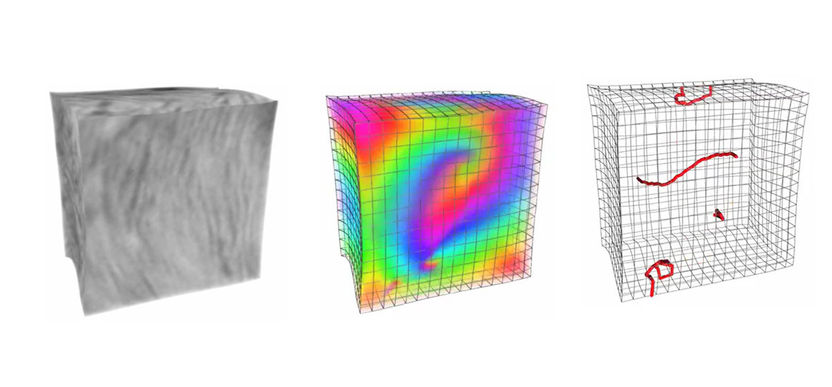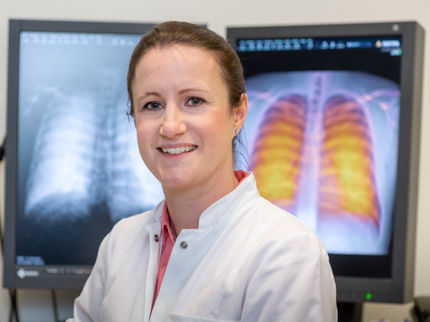Maelstroms in the heart
New, promising imaging technique for cardiac arrhythmias
Every five minutes in Germany alone, a person dies of sudden cardiac arrest or fibrillation, the most common cause of death worldwide. This is partly due to the fact that doctors still do not fully understand exactly what goes on in the heart during the occurrence. Until now, it was impossible to visualize dynamic processes in the fibrillating heart muscle, or myocardium. In Nature, an international team of researchers headed by Jan Christoph and Stefan Luther of the Max Planck Institute for Dynamics and Self-Organization and Gerd Hasenfuß of the Heart Center at the University Medical Center Göttingen show for the first time how vortex-like, rotating contractions that underlie life-threatening ventricular fibrillation can be observed inside the heart with the help of a new imaging technique, which can be used with existing ultrasound equipment. In the future, this newly developed imaging technique may help medical doctors to image and thus identify heart rhythm disorders, helping them to better understand cardiac disease and further develop new, more effective methods for treatment.

From ultrasound images (left), Max Planck researchers have reconstructed how the heart muscle contracts vortex-like (centre) in cardiac arrhythmia. This also allows the researchers to locate the filaments (right) that form the centre of the vortices. It is hoped that these insights will provide the basis for developing improved treatment methods.
© MPI for Dynamics and Self-Organization
When the heart muscle no longer contracts in a coordinated manner, but simply flutters or twitches – a condition referred to medically as “fibrillation” – it is a highly life-threatening situation. If the ventricles, the main chambers of the heart, twitch in this disorderly way, there is just one opportunity for medical intervention: the heart must be defibrillated within a few minutes with a strong electrical shock, which is very painful and can damage the heart’s tissue. Fibrillation of the atria, on the other hand, is not directly life-threatening; however, if left untreated it can have dire consequences. For over 100 years, researchers have sought to understand the mechanisms behind fibrillation so as to improve treatment options. "The key to a better understanding of fibrillation lies in a new, high-resolution imaging technique that allows processes inside the heart muscle to be observed," says Stefan Luther, Leader of the Biomedical Physics Research Group at the Max Planck Institute for Dynamics and Self-Organization and Professor at University Medical Center Göttingen.
Diagnostic breakthrough
"The mechanical movements of the myocardium during fibrillation are highly complex, but they are also highly characteristic – almost like a fingerprint of fibrillation," says Jan Christoph, a researcher at the Max Planck Institute for Dynamics and Self-Organization and the Heart Center at the University Medical Center Göttingen and lead author of the study. Together with Stefan Luther and an international team of researchers, the physicist has presented an imaging method that allows the fibrillating myocardium to be visually time-resolved in three dimensions, and therefore much more accurately than was previously possible – and it does so using clinically available high-resolution ultrasound equipment.
The new diagnostic method will help to make the treatment of ventricular fibrillation and possibly also atrial fibrillation more effective. The improved understanding of fibrillation, which can be achieved with the procedure, could help to advance the development of novel defibrillation techniques. In low-energy defibrillation, for example, the electrical pulses used to stop fibrillation are much weaker but much more targeted compared to the current, very painful method, which uses high-energy electric shocks. With the new form of ultrasound imaging, researchers could learn how to use low-energy pulses to restore normal heart rhythm.
The Göttingen-based researchers are now refining the method so that it will also be able to visualize the complex excitation dynamics, which occur during atrial fibrillation. In the future, cardiologists will be able to see exactly where pathological foci of excitation need to be removed by ablation. The new ultrasound method may also be helpful in the research, diagnosis and treatment of heart failure, during which the myocardial cells do not work effectively as their coordinated contractile movements are disrupted. Doctors would be able to determine the causes with the help of detailed ultrasound scans, enabling them to detect heart failure earlier and treat it more effectively.
Electrical waves cause mechanical contractions of the heart
Every heartbeat is triggered by electrical waves of excitation that propagate through the myocardium at high speed and cause the myocardial cells to contract. If these waves become turbulent, the result is cardiac arrhythmia. Doctors have long known that in cardiac arrhythmias, rotational electrical waves of excitation swirl through the heart muscle. Until now, their investigations of cardiac arrhythmias have focussed on such electrical vortices. However, they have not been able to ascertain a full picture of the dynamics, neither in the laboratory nor in the clinical setting. The MPIDS researchers took a different approach. Instead of concentrating on electrical stimulation, they looked at the twitching contractions of the fibrillating myocardium. "Until now, little importance was attached to the analysis of muscle contractions and deformations during fibrillation. In our measurements, however, we saw that electric vortices are always accompanied by corresponding vortex-shaped mechanical deformations," physicist Jan Christoph explains.
Ventricular fibrillation in 3D
In order to visualize the trembling movements inside the heart muscle in three dimensions and to correlate them with the electrical excitation of the heart, the researchers developed new high-resolution ultrasound measuring methods. They also showed that these methods can be used in high-performance ultrasound equipment that is already in routine use in many cardiology institutions. By analyzing the image data of the muscle contractions, they were able to observe exactly how areas of contracted and relaxed muscle cells move in a vortex through the myocardium during fibrillation. They also observed filament-like structures that were previously known to physicists only in theory and from computer simulations. Such a filament-like structure resembles a thread and marks the eye of the whirlpool-like wave or cyclone moving through the myocardium. It is now possible for the first time to pinpoint these centres of the vortices inside the myocardium.
In addition to ultrasound scans, the researchers used high-speed cameras and fluorescent markers that reveal the electrophysiological processes in the myocardium. The images obtained confirmed that the mechanical vortices correspond very well with the electrical vortices.
According to the researchers in Göttingen, ultrasound technology has progressed tremendously in recent years in terms of image quality and imaging speeds, and the potential of modern ultrasound technology has yet to be fully exploited. "Together with the immensely increased computing power of modern computers and rapid advancements in computer graphics and digital image processing, new measurement and visualization possibilities are being created for investigating the heart. We can apply these developments in medicine today," Jan Christoph says.
From physics to medicine
The study is an example of successful interdisciplinary collaboration between physicists and doctors at the DZHK. "This revolutionary development will open up new treatment options for patients with cardiac arrhythmias. As early as 2018, we will use the new technology on our patients to better diagnose and treat cardiac arrhythmias and myocardial diseases," says Gerd Hasenfuß, co-author of the study, Chairman of the Göttingen Heart Research Center Göttingen and the Heart Center at the University Medical Center Göttingen. Stefan Luther is certain of one thing: "Peering deeply into the inner dynamics of the heart marks a milestone in heart research and will decisively shape our understanding and treatment of heart disease in the future."
Original publication
See the theme worlds for related content
Topic world Diagnostics
Diagnostics is at the heart of modern medicine and forms a crucial interface between research and patient care in the biotech and pharmaceutical industries. It not only enables early detection and monitoring of disease, but also plays a central role in individualized medicine by enabling targeted therapies based on an individual's genetic and molecular signature.

Topic world Diagnostics
Diagnostics is at the heart of modern medicine and forms a crucial interface between research and patient care in the biotech and pharmaceutical industries. It not only enables early detection and monitoring of disease, but also plays a central role in individualized medicine by enabling targeted therapies based on an individual's genetic and molecular signature.

























































